ISSN ONLINE(2319-8753)PRINT(2347-6710)
ISSN ONLINE(2319-8753)PRINT(2347-6710)
B. Beeralingegowda1 and V. D. Gundakalle2
|
Visit for more related articles at International Journal of Innovative Research in Science, Engineering and Technology
Self-compacting Concrete (SCC) is highly flowable, stable concrete that can spread readily into place and fill the formwork without any consolidation and without undergoing any significant segregation. In recent years, self-compacting concrete has gained wide application in the construction industry. The paste of SCC requires high viscosity as well as high deformability. Stability and flowability of SCC is achieved by increasing the solid fraction of paste phase of concrete i.e. increasing the cement content or employment of some mineral admixtures. However, increasing the cement content is not feasible, and may cause high cost and some other technical problems such as higher heat of hydration and higher drying shrinkage. Alternatively, pozzolanic fillers are frequently used to optimise the particle packing and flow behaviour of cementitious paste in SCC mixtures. In this study, cement content in the SCC mix is replaced with various percentages of limestone powder (LP) (0 to 30%), the fresh and hardened properties and also the durability characteristics of SCC such as acid attack and chloride attack are studied. The experimental results were validated by regression analysis. It is observed that limestone powder can be effectively used as a mineral additive in SCC
Keywords |
| Self-compacting concrete, Limestone powder, Fly ash, Chemical attack, Regression analysis. |
INTRODUCTION |
| Self-compacting concrete (SCC) is an innovative concrete that does not require vibration for placing and compaction. It is able to flow under its own weight, completely filling formwork and achieving full compaction, even in the presence of congested reinforcement. The hardened concrete is dense, homogeneous and has the same engineering properties and durability as traditional vibrated concrete [1]. The use of SCC can improve productivity in structural applications such as repair and facilitates the filling of restricted sections. Such concrete has been widely used to facilitate construction operations, especially in sections possessing special difficulties to casting and vibration such as bottom, sides of beam, girders and slabs [2]. Use of SCC saves time, improves working environment and opens the way for the automation of the concrete construction. Because of significant benefits, SCC may gradually replace most of the ordinary concrete currently produced. SCC mixes usually contains a powerful superplasticizer and often use a large quantity of powder materials and/or viscosity modifying admixtures. The superplasticizer is necessary for producing a highly fluid concrete mix, while the powder materials or viscosity modifying agents are required to maintain sufficient stability/cohesion of the mix, hence reducing bleeding, segregation and settlement. As an increase in cement content leads to a significant rise in material cost and often has other negative effects on concrete properties (e.g., increased thermal stress and shrinkage, etc.), the requirement for increased powder content in SCC is usually met by the use of pozzolanic or less reactive filler materials. These may include pulverised fuel ash (PFA), granulated ground blast furnace slag (GGBS), lime stone powder etc [3]. Limestone powder (LP) is produced as by-product of limestone crushers. Large volumes of this powder are accumulated and it is a big problem. Utilization of this by-product may solve the problems related to disposal, environmental pollution and health hazards. Limestone powder has been used to produce cement in some countries, and in the recent EN197-1 specification, it is mentioned that up to 35% of limestone powder can be added to produce Portland limestone cement and Portland composite cement. The use of limestone powder in concrete, particularly in SCC, has been widespread in Sweden and France, where limestone powder is stored in silos alongside the cement in ready-mix concrete plants. The addition of fine limestone powder can significantly improve the workability of self-compacting concrete [4] and it has shown to enhance the rate of cement hydration and strength development, as well as to improve the deformability and stability of fresh SCC. Preliminary studies carried out as part of a major European research project on SCC suggested that fine limestone powder could be used effectively in SCC. The SCC mixes containing fine limestone powder showed improved fresh properties, higher than expected compressive strength and excellent surface finish. This was attributed to improved particle packing and water retention of the fresh mixes, as well as to possible chemical reactions involving cement hydrates and CaCO3. It is not certain, however, if different types and fineness of CaCO3 powders could offer similar benefits to SCC [5]. |
| In this study, cement content in the SCC mix is replaced with various percentages of limestone powder (0 to 30%). The objective of this investigation is to study the influence of limestone powders in SCC on the fresh and hardened properties and also the durability characteristics of SCC, such as acid attack and chloride attack. The experimental results were validated by regression analysis. It is observed that limestone powder can be effectively used as a mineral additive in SCC. |
MATERIALS AND EXPERIMENTATION |
A. Materials |
| • Cement: Ordinary Portland cement (OPC) (43 grade) with specific gravity of 3.15 and fineness of 290 m2/kg confirming to IS 8112:1989 is being used. |
| • Fine aggregate: The sand used for the experimental program was locally procured and was confirming to zone-III. The specific gravity of fine aggregate was 2.65 and bulk density 1600 kg/m3. |
| • Coarse aggregate: Locally available crushed angular coarse aggregate having the maximum size of 12.5 mm were used in the present work. The specific gravity of coarse aggregate was 2.82 and bulk density 1553 kg/m3. |
| • Fly ash: Fly ash from Raichur thermal power station, Karnataka has been used as cement replacement material with a specific gravity of 2.2 and fineness of 229 m2/kg. |
| • Limestone powder: Locally available fine limestone powder is also used as partial cement replacement material. |
| • Water: Potable tap water was used for the preparation of specimens and for the curing of specimens. |
| • Superplasticizer: Poly-carboxylic ether based superplasticizer was used. Relative density of superplasticizer was 1.08 at 250 C. |
B. Mixture Proportions |
| In the present investigation the percentage of fly ash is fixed as 30% by carrying out trials on workability test and for this percentage of fly ash, the limestone powder is varied as 0%, 5%, 10%, 15%, 20%, 25% and 30% and changes in the behaviour of SCC in fresh state and hardened state is being studied. The fly ash and limestone powder replaces the cement partially. Nan-su method of mix design is adopted for designing M40 grade of mix. The mix proportion and the mix designation for various percentage of replacement of cement by limestone powder are shown in table 1 and 2. |
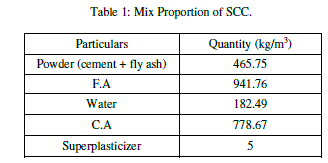 |
| Necessary care is taken in proportioning the ingredients. The cement, fly ash and fine aggregates were mixed dry until the mixture was thoroughly blended in the case of control mix and in the case of other mixes with limestone powder. The coarse aggregate was then added and mixed to distribute it uniformly. Initially 70% of water was added to the dry mixture to attain homogeneity and then the remaining 30% suspension of superplasticizer prepared in water was added and the mixing was continued to obtain homogeneous mix. It is found that the process needs longer time than for conventional concrete mixes. |
| Cube specimens of size 150 mm and cylindrical specimens of diameter 150 mm and length 300 mm were cast to determine compressive and splitting tensile strength respectively. Flexural strength is calculated by preparing beam specimens of size 100×100×500 mm. |
C. Testing |
| Tests on fresh SCC were determined by conducting a) slump flow test and T50cm slump flow test b) V-funnel flow test c) U- box test d) L- box test d) Orimet test and tests on hardened properties were determined by conducting cube compressive strength, splitting tensile strength, flexural strength. Durability tests were carried out for acidic attack test and chloride attack test. |
RESULTS AND DISCUSSION |
A. Fresh properties |
| The workability test of SCC mixes with different percentage replacement of cement with limestone powder are determined by conducting tests such as slump flow test and T50 cm slump flow test, V-funnel test, U- box test, L- box test, and Orimet test for each percentage replacement. The results are tabulated for all the mixes with EFNARC recommended limits (RL) [1] in the table 3. It is observed that up to 20% of cement can be replaced by limestone powder without affecting self compactability. |
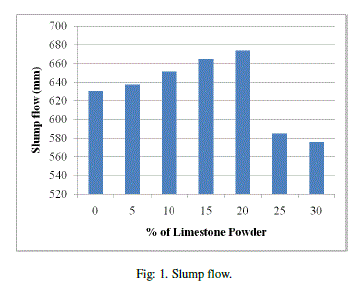 |
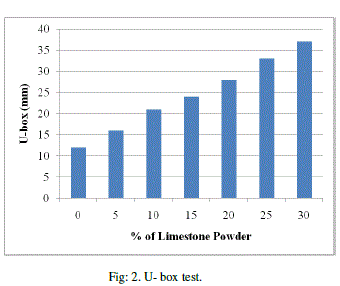 |
| From the table 3, and fig 1, 2, 3, 4, 5, 6, it is observed that first five mixes RM, M1, M2, M3 and M4 were admissible and met the SCC acceptance criteria. It is observed that up to 20% of cement can be replaced by limestone powder without affecting self compactability. The mixes M5 and M6 show lower self compactability, because with the increase in limestone powder the mix becomes denser and hence less self compactable. Comparison of workability test results of different combinations of mixes with the reference mix show that with increase in the percentage of limestone powder up to 20% in the mixes, the mixes were more workable. |
B. Hardened properties |
| a) Compressive strength |
| The compressive strength test on cube specimens is conducted as per IS 516-1959. The test results on cube compressive strength of SCC is given in Table 4 and plotted in Fig 7. It has been observed that the compressive strength increases up to 20% limestone powder content but decreases on further addition of limestone powder. Maximum increase of 17.74 percent in compressive strength has been observed at 20 percent replacement of cement by limestone powder compared with reference concrete. Further it has been found that the increase in compressive strength observed is, when the cement has been replaced from 15 to 20 percent. Beyond 20 percent replacement the compressive strength is higher than reference mix, but the self compactability characters show downward trend. From the Fig 7 it is observed that the best-fit polynomial equation for compressive strength is y = -0.019x2 + 0.705x + 40.78 and the correlation coefficient r2 = 0.711. |
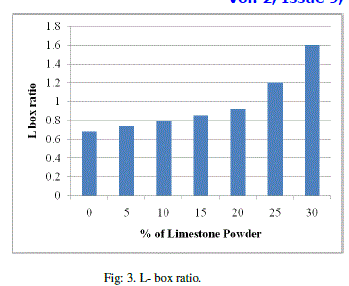 |
| b) Split tensile strength |
| Split tensile test was carried out on compression testing machine as per IS 5816-1999. The test results on split tensile strength of SCC is given in Table 4 and plotted in Fig 8. It is observed that the variation in splitting tensile show the same trend as observed in compression strength. Increase in splitting tensile at 20% replacement of cement by limestone powder show maximum increase of 18.91% compared with reference mix. From the regression analysis of the test results shown in Fig 8, it is observed that the best-fit polynomial equation for split tensile strength is y = -0.002x2 + 0.079x + 3.421 and the correlation coefficient r2 = 0.863. |
| For evaluating the flexural strength, beam specimens of dimensions 100×100×500 mm were prepared. For testing two point loading was adopted on an effective span of 400 mm as per IS 516-1959. The test results are given in Table 4 and plotted in Fig 9. It has been observed that the 28-day flexural strength increases up to 20% replacement of cement by limestone powder but further addition of limestone powder decreases flexural strength. From the Fig 9 it has been observed that the best-fit polynomial equation for flexural strength is y = -0.001x2 + 0.051x + 6.045 and the correlation coefficient r2 = 0.873 |
| e) Chloride test |
| Chloride test was conducted on cube specimens after 28 days of curing. To evaluate the extent of chloride ingress, a small portion of concrete was extracted by drilling machine at a depth of 30 mm, 60 mm and 75 mm from top of the specimen. This powder sample was titrated against Silver Nitrate (AgNO3) solution to find the chloride content in the powder sample. It is observed from the Fig 10, that the chloride content decreases with increase in depth from the top. Results also indicate reduction in chloride with increase in replacement of cement by limestone powder, and beyond 20% the values are increasing but still lower than reference mix. |
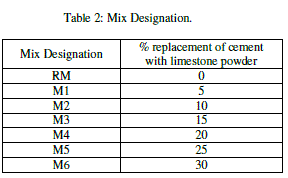 |
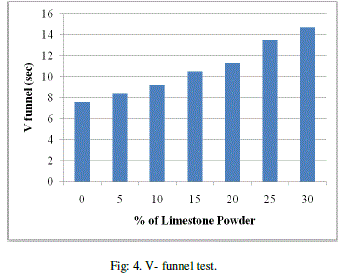 |
CONCLUSIONS |
| From the experimental investigation it was observed that the replacement of cement with limestone powder as mineral admixture in SCC with 30 percent fly ash show improved workability and mechanical properties up to 20 percent. |
| Chloride content of SCC decreased with increase of cement replacement with limestone powder up to 20%. Further it was also observed that the chloride content reduced with increase in depth from the top surface of specimen. Compressive strength of SCC subjected to acidic attack decreased compared with reference mix. |
| Regression analysis of mechanical properties indicated that the polynomial relationship gives good coefficients of correlation. |
References |
|